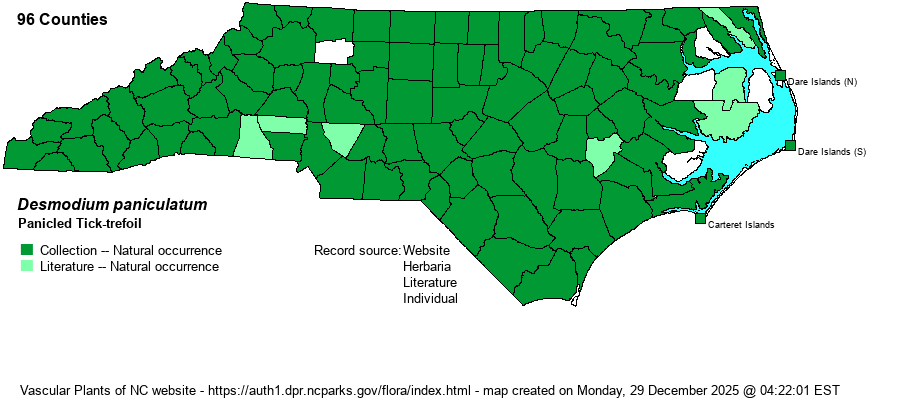| Author | (L.) de Candolle | |
| Distribution | Statewide, and certainly found in all 100 counties.
This is a widespread and common species across the eastern states, ranging from ME west to NE, and south to the Gulf Coast of FL and TX. | |
| Abundance | Common to very common nearly statewide, but seemingly infrequent in a few far eastern counties. One of the most widespread and abundant Desmodium species in NC and the East. | |
| Habitat | This species occurs in the typical Desmodium places -- woodland borders, old fields, powerline clearings, thickets and margins, and other dry to mesic openings, usually in full to only partial sun. It is not as limited to dry soils as some others in the genus, and more likely to be found within forests. |
| Phenology | Blooms from June into September, and fruits from August to October. | |
| Identification | This is a distinctive, moderately tall Desmodium with a normally smooth to only slightly pubescent stem. The erect to leaning stem reaches about 3 feet tall, with wide-spreading branches. As there are not many leaves on the branches and the 3 leaflets are so narrow (usually), the aspect of the plant is one of being "skinny". The leaflets are narrow to very narrow, being narrowly lanceolate (slightly tapering to the apex), about 2-2.5 inches long and less than 1/2-inch wide normally, but can be nearly 1 inch wide on some specimens. The leaves are rather smooth. There are numerous panicles of flowers, growing from axils, with the flowers being pink and small (about 1/4-inch long). The pods are not normally needed in the species identification, owing to the very narrow and tapering leaflets. This is such a widespread and numerous species in nearly all of the state that it can be seen almost daily in field work, as long as you are in drier places and working along wooded margins, powerline cuts, and roadbanks. | |
| Taxonomic Comments | A number of species currently considered as valid in NC were once included within this widespread species. Currently, there are a handful of varieties named, and Weakley (2018) lists two -- the wide-ranging (in the state) D. paniculatum var. paniculatum and the Coastal Plain only (in NC) D. paniculatum var. epetiolatum.
| |
| Other Common Name(s) | Panicledleaf Tick-trefoil, Narrowleaf Tick-trefoil | |
| State Rank | S5 | |
| Global Rank | G5 | |
| State Status | | |
| US Status | | |
| USACE-agcp | FACU link |
| USACE-emp | FACU link |

